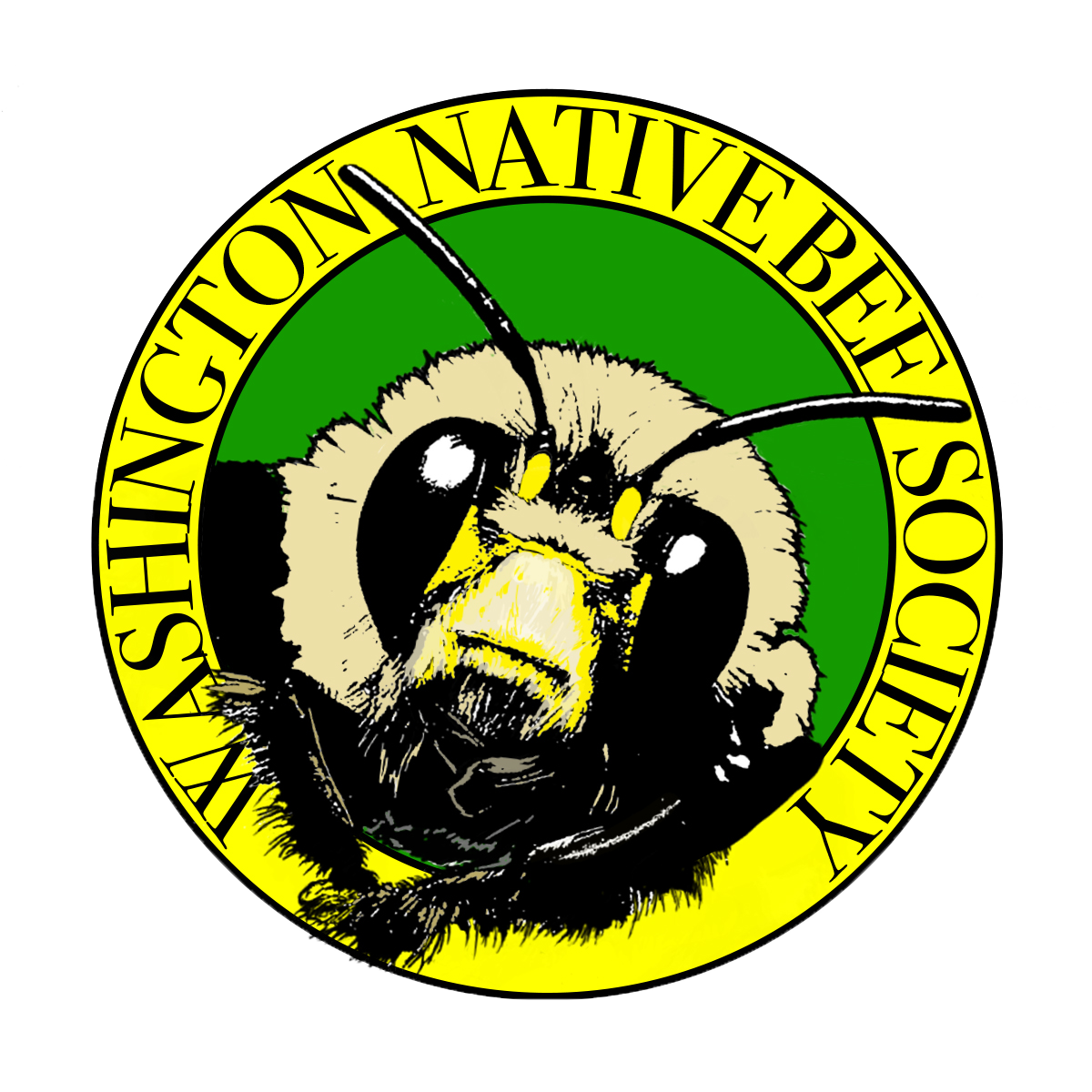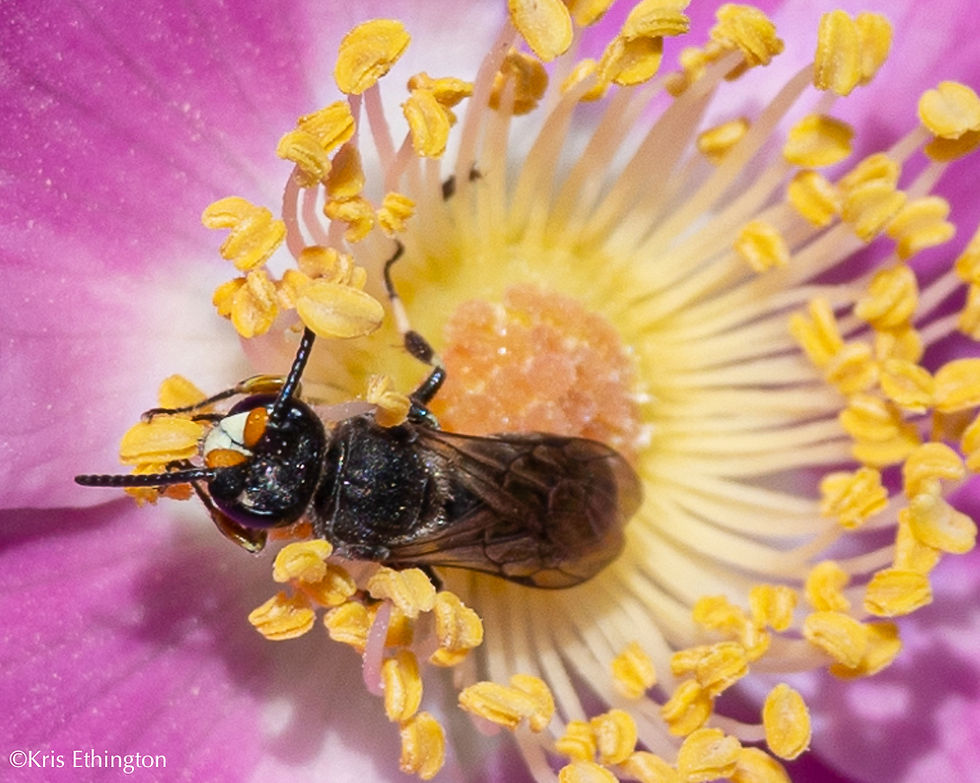Rare Dune Specialist – Habropoda miserabilis
- Kris Ethington

- Apr 6
- 5 min read
Updated: Jul 29
Washington’s coast and Puget Sound shorelines are geologically beautiful and dynamic. Interactions between water and land create diverse habitats that play key roles in supporting biodiversity and providing ecosystem services. Sand dunes are among the most vulnerable and important habitats for solitary bees. North America is home to ten sand loving (psammophile) bee genera. Psammophile refers to organisms that are adapted to living in sandy environments.

Observing native bees in their natural habitats is fascinating. I encountered my first silver dune digger bees, both male and female, visiting Seablush (Plectritis congesta) and Tall Oregon Grape (Mahonia aquifolium) in a spring blooming coastal prairie and dune habitat near my home. These bees were initially identified to the genus, Habropoda, and later to species, Habropoda miserabilis (Pacific Dune-Digger), confirmed by my photos of a female constructing her dune nest in April 2022. Following this, I joined the iNaturalist Project about ground nesting bees, GNBee.org. This rare dune specialist has a limited endemic distribution along the Pacific Coast from southern BC, Canada to Baja California. According to NatureServe2024, the conservation status for Habropoda miserabilis is G2 – Imperiled globally.

Habropoda Characters
The genus Habropoda (Mountain Digger Bees) is one of two genera, including Anthophora, in the United States belonging to the Anthophorini tribe. The genera are difficult to tell apart. However, with clear wing venation photos showing the three submarginal cells where the first recurrent vein meets the line dividing the second and third submarginal cells straight on, forming a + or an x, experts can verify a bee to the genus Habropoda. In contrast, in Anthophora, the first recurrent vein intersects the second submarginal cell near the middle, making a T instead.
Nesting Biology
Habropoda miserabilis are silver and black, somewhat robust in size. Males have a white clypeus (face) and are smaller than females. Habropoda emerge in late winter to early spring. Males emerge first, aggregate with other males flying over the nesting site, and wait for emerging females. This early behavior of male bees, flying low over the ground, is the best time to identify bee nesting locations. Once a female emerges, 7-10 males will form a mating ball with one successfully mating with her. She will begin excavating her dune burrow shortly after. Researchers described that each burrow is constructed about 30 inches deep, with multiple chambers to form a wagon wheel with one egg laid in each spoke. Females use the hairs on their strong back legs in a sweeping motion to move the sand out from the nest chambers.

A female Habropoda initially visits flowers close to the nest. I observed her preference for an early blooming dune endemic, Small-flowered Blue-Eyed Mary (Collinsia parviflora). She collects pollen and nectar with pollen carrying hairs (scopae) on her hind legs to provision each nest cell. Once provisioned, she closes that cell. Like many solitary bees, each female may only produce 10 offspring. Each egg develops and pupates within a few weeks and overwinters as an adult underground until emerging next spring. I’ve observed that the rooting of sparse dune vegetation appears to assist in surface and below ground nest structure. I’ve encountered a female provisioning her nest into early June. Solitary ground nesting bees tend to nest in the same sites as their mothers, making identification of their established underground nests critically important for conservation. Some bees have been known to nest in the same site for decades.

Habropoda miserabilis Nesting Studies
As my bee nesting studies continued, I turned my attention to Washington State Parks in search of small populations of Habropoda miserabilis bees in similar coastal habitats. I successfully photographed male and female Habropoda bees visiting Tall Oregon Grape flowers at Fort Flagler State Park in 2023 and 2024. However, I was unable to locate dune nesting there. Undeterred, I visited Fort Worden State Park, where I found three female Pacific Dune-Digger bees as they were excavating their dune burrows in April 2024. I shared the site location with the Fort Worden State Park team who were enthusiastic about incorporating this new information into their habitat stewardship and conservation program. Later that month Project GNBee, an iNaturalist project led by post-doctoral researcher, Jordan Kueneman, expressed GNBee’s interest in tracking these Habropoda miserabilis aggregations through time, stating that, “Studying this aggregation over time can provide missing information about the biology of the bees, as well as opportunities for potential conservation efforts for this site and other ground-nesting bees.”

This year, I spent the first week of April studying the emergence of male Habropoda bees at the nesting site in my private community. I watched the number of males patrolling increase slowly and then dramatically through the week. I captured the mating ball behavior and observed the number of bees grow. Initially there were under 40 bees, then 50 or more, and now there are more than 100! Each site is different but the timing for the area tends to be similar. I visited Fort Worden again and observed 20-40 males and a few females during nest construction that day. I returned to Fort Flagler State Park and finally discovered the location of the nest site! There were 2 or 3 sections of the sandy (eroding) bluff bank with moderate male behavior visible. I observed a few females pushing out the sand from their vertical burrows and one female entering her vertical burrow. The site is elevated and the base unstable, making observations challenging.
As a native bee enthusiast, photographer, and volunteer with the Washington Native Bee Society, I am eager to collaborate with those who manage our public lands and to participate in community level citizen science that can lead to protection of native bees and their nesting habitats.




Comments